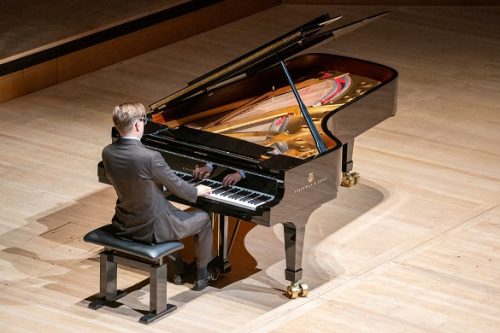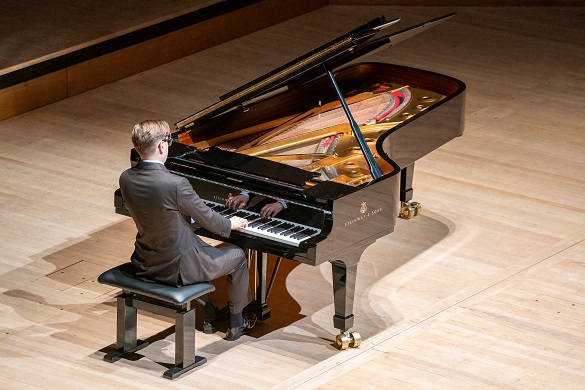 United Kingdom Bach: Víkingur Ólafsson (piano). Royal Festival Hall, London, 22.9.2023. (CSa)
United Kingdom Bach: Víkingur Ólafsson (piano). Royal Festival Hall, London, 22.9.2023. (CSa)

JS Bach – Goldberg Variations, BWV.988
It is said that Bach’s insomniac patron, Count Keyserling, in need of musical entertainment to help him pass his sleepless nights, commissioned some clavier pieces from the composer to be played by the court’s resident harpsichordist Johann Gottlieb Goldberg. The result? A monumental set of 30 exquisite variations topped and tailed by a repeated aria of serene beauty. Any pianist courageous enough to embark on a scoreless recital of this terrifyingly complex and demanding work requires a prodigious memory, a flawless technique, exceptional physical endurance, intellectual rigour and a wellspring of emotional intelligence. Víkingur Ólafsson, sometimes described as Iceland’s Glenn Gould, possesses all these qualities and more. In a compelling performance to a capacity Royal Festival Hall audience, he combined deep spirituality and pianistic brilliance. Ólafsson, 6 foot 2 inches in height and modishly attired in a cropped slim-fit suit, skinny tie and oversized spectacles seems considerably younger than his 39 years. Seated at the piano, his head bowed low over the keyboard, he embarked on Bach’s monumental musical journey masterfully but modestly. His style was engagingly individualistic but always understated. There were no distracting gestures or extraneous physical flourishes. His sole mission was to serve the music.
The opening aria, a courtly sarabande, has been likened to the start of a gentle stroll around a vast Gothic cathedral, and the ensuing variations compared to a series of beautifully wrought carvings and statuary which demand closer inspection. Ólafsson’s introduction was one of measured calm and provided a lofty but simple backdrop against which to admire the elaborately detailed First Variation – a polonaise-like dance which was played with thrilling energy and impeccable precision.
Each of the 10 sets of variations begins with a dance which Ólafsson imbued with a sense of playfulness and joy. Variation 4, a triple-time baroque passepied, tripped lightly and graciously, while the gigue in Variation 7 set the foot tapping. The intricately ornamented Fughetta (Variation 10), punctuated by millisecond trills, was perfectly executed, and the slow variations were subtly coloured and heartrendingly tender. If displays of pyrotechnical pianism set your heart racing, then Ólafsson’s virtuosic hand-crossing skills and dizzyingly executed flourishes in Variations 14, 17 and 20 called for the intervention of a cardiologist. They were simply breathtaking. In the slower-paced variations, such as number 21 (a sombre Canone alla Settima), Ólafsson brought soothing introspection. Variation 25, known as ‘the black pearl’, is generally acknowledged to be the emotional epicentre of the work. Here, Ólafsson tapped the dark and yearning sadness at its core, replacing the exhilaration of the faster movements with a sense of profound calm. The last few variations were infused with playfulness and good humour. In number 28, the delicate melody in Ólafsson’s right hand shimmered, while his left hand beat time with the accuracy of an atomic clock. Finally, the new themes in number 30 – the Quodlibet – rang out triumphantly like the peeling of cathedral bells. A reprise of the opening aria – unadorned and softly played – brought this glorious and inspirational journey to an appropriately tranquil end.
Chris Sallon
